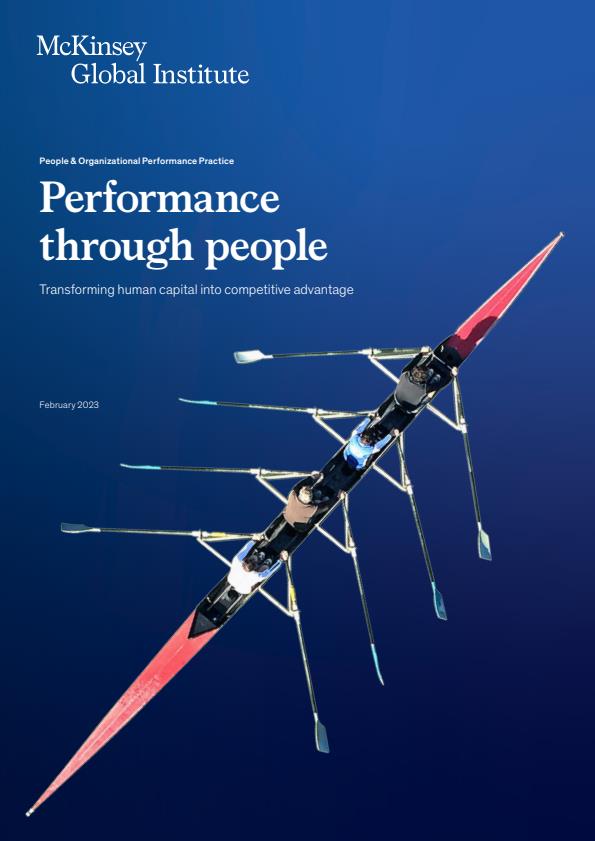At a glance
- When companies emphasize skill development, it pays off for workers. Skills learned on the job contribute 46 percent of the average person’s lifetime earnings, and companies that build human capital are more likely to propel their employees into higher earnings brackets over the course of a career.
- Building human capital also pays off for firms in the form of more consistent earnings and greater resilience during crisis. In addition to being more consistent than their sector peers, human capital builders are better at retaining talent, with attrition rates that are about 5 percentage points lower.
- Some firms (“People + Performance Winners”) prioritize developing their employees and manage to deliver top-tier profitability at the same time. These companies are more likely to become large-scale “superstars.” They exist in all sectors and average more than $1 billion in economic profit.
- People + Performance Winners have a distinctive organizational signature that challenges and empowers employees while fostering bottom-up innovation. This form of organizational capital contrasts with that of other top-performing firms, which tend to be more top-down and transactional. This management style seems to activate human capital and create a tangible competitive advantage.
MGI’s previous research has shown that human capital development pays off for workers, with skills learned on the job accounting for almost half of the average person’s lifetime earnings. But does investing in people actually benefit companies? Most business leaders agree that it’s the right thing to do. But they are less clear on how those efforts relate to the bottom line—and why some organizations are so much more effective than others at turning human capital into a real competitive advantage.
To explore these questions, we analyze 1,800 large companies across sectors in 15 countries, sorting them based on two factors: how much they focus on developing human capital and whether they financially outperform their sector peers.
One subset in particular stands out: People + Performance Winners (P+P Winners) excel at creating opportunities for their employees to build skills (which we measure by looking at internal mobility, training hours, and organizational health scores) while consistently clearing the highest bar for financial performance. Another group, Performance-Driven Companies, similarly achieve top-tier financial results but do not put the same kind of emphasis on skills development and the work environment. A third group, People-Focused Companies, put resources into developing employees but are unable to translate that into strong financials. Finally, the majority of firms are Typical Performers that stand out on neither dimension.
P+P Winners distinguish themselves from Performance-Driven Companies in two important ways. They achieve more consistent results and have greater earnings resilience, and they also have a superior ability to attract and retain talent (Exhibit 1). These are important advantages at a time when companies are facing economic headwinds and labor shortages.

While they closely tracked Performance-Driven Companies on profitability and shareholder returns over the prepandemic decade, P+P Winners were roughly 1.5 times more likely to remain in the top tier year after year, and they had about half the earnings volatility.
P+P Winners are not only consistent through the normal ups and downs of business cycles; they are also more resilient in times of crisis. When the pandemic struck, they were more likely to weather the crisis and avoid taking major hits. Only 54 percent of P+P Winners saw a reduction of more than 0.5 percentage point in return on invested capital from 2019 to 2020, compared to 65 percent of Performance-Driven Companies. In fact, 36 percent of P+P Winners saw an increase of more than 0.5 percentage point (versus 29 percent of Performance-Driven Companies). More P+P Winners found growth opportunities in the crisis years as well. From 2019 to 2021, they grew revenue twice as fast as Performance-Driven Companies (8 percent versus 4 percent). Organizations that had spent years building reserves of loyalty, goodwill, and innovative capacity by investing in people may have had more internal resources to draw on when the chips were down.
Investing in human capital is associated with consistency and resilience for other companies, too. In the two segments that are not top performers financially, People-Focused Companies demonstrated greater stability than Typical Performers. Typical Performers were 1.5 times more likely than an average firm in our sample to remain in the bottom quintile of profitability in nine out of ten years, while People-Focused Companies were only 1.1 to 1.3 times as likely. The latter also demonstrated greater resilience during the pandemic, growing their revenue twice as fast as Typical Performers (6 percent versus 3 percent) from 2019 to 2021.

WATCH
A McKinsey event on "Performance through people: Transforming human capital into competitive advantage"
P+P Winners are also talent magnets, with attrition rates almost five percentage points lower than those of Performance-Driven Companies. Their employees report higher job satisfaction and are 1.3 times more likely to move into higher lifetime earnings brackets than employees of Performance-Driven Companies. People-Focused Companies have similarly high levels of employee satisfaction and even lower attrition than P+P Winners, although not with the same stellar financial performance.
How do P+P Winners manage to succeed on both fronts? While investing in people is important, our research shows that another ingredient is needed to bring out their best and channel their efforts into results: organizational capital—that is, the management practices, systems, and culture within each company. This concept encompasses everything from training programs to workflows, department and team structures, employee communications, norms, culture, and leadership. When these elements are effective, they can turn a collection of talented individuals into a cohesive team.
Organizational capital is the fabric that surrounds employees, and its pattern matters. We compare the practices of each group of companies using McKinsey’s Organizational Health Index diagnostic and other firm-level metrics. P+P Winners have a distinctive signature characterized by consultative and challenging leadership styles; bottom-up innovation and collaboration; positive and inclusive work environments; and rewards and advancement opportunities for employees (Exhibit 2). Performance-Driven Companies have similar leadership styles but are more externally oriented to customers and competitors, with less emphasis on engaging their people through company-wide innovation, motivation, work environment, and on-the-job coaching. People-Focused Companies have many practices in common with P+P Winners (such as motivating employees and creating positive work environments), but they are less results-oriented, and they do not emphasize bottom-up innovation.

On average, companies spend about one-third of their revenue on human and organizational capital (which we measure by using the proxy of compensation for the former and adjusted selling, general, and administrative spending for the latter). This is a significant investment, and companies need to make it as productive as possible. P+P Winners achieve roughly 30 percent higher revenue growth than both Performance-Driven and People-Focused Companies for every dollar they invest in human and organizational capital. By contrast, Performance-Driven Companies generate higher return on R&D and sales and marketing investment—but they have the potential to boost their overall results even further by making their investments in people and workplace systems more effective.
Corporate leaders need a deeper focus on the nuances of organizational capital. Human capital is not merely a labor input; people are any company’s core asset. The workplace should work for employees, with coaching to help them develop, structures for support, and workflows that remove frustrations. Employees know what works on the front lines, and their voices and viewpoints should inform any redesign. Beyond improving the day-to-day experience for workers at every level, these principles can enhance competitiveness and adaptability in a fast-moving world.
In some cases, altering company-wide policies and systems could spur positive change. In others, it will take behavior change from leaders. While C-suite executives can articulate the vision and set the example, frontline and middle managers are key actors since they set the tone for individual teams, have greater visibility into what’s working, and can be the biggest influence on the employee experience.
Not every company will choose to follow the P+P Winner template. Some are singularly driven by financial results; focusing on people may not be in their DNA. Remaking organizational culture is a difficult, ongoing commitment that requires energy, self-reflection, and a willingness to change familiar patterns.
But companies that adopt a more people-oriented focus along with a more challenging and empowering organizational culture have a lot to gain. In addition to boosting financial returns, they can improve their consistency, resilience, talent retention, employee loyalty, and reputation—and these are the hallmarks of companies that thrive over the long term.



